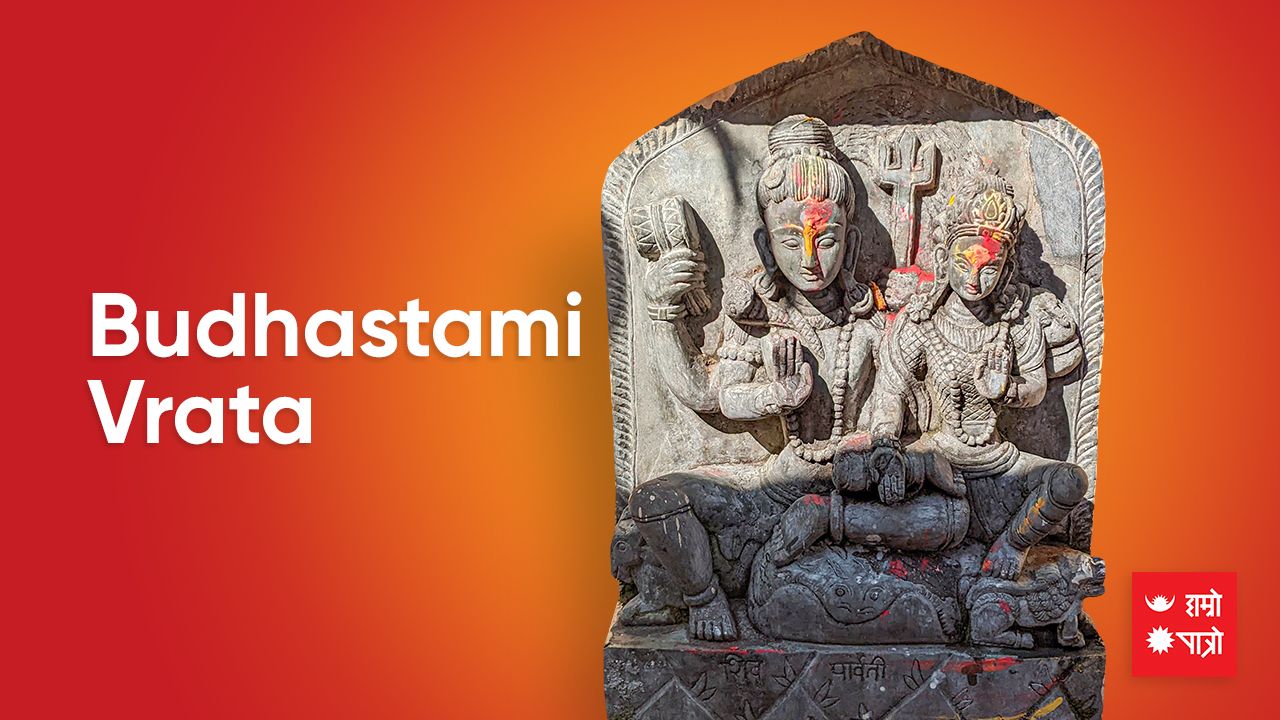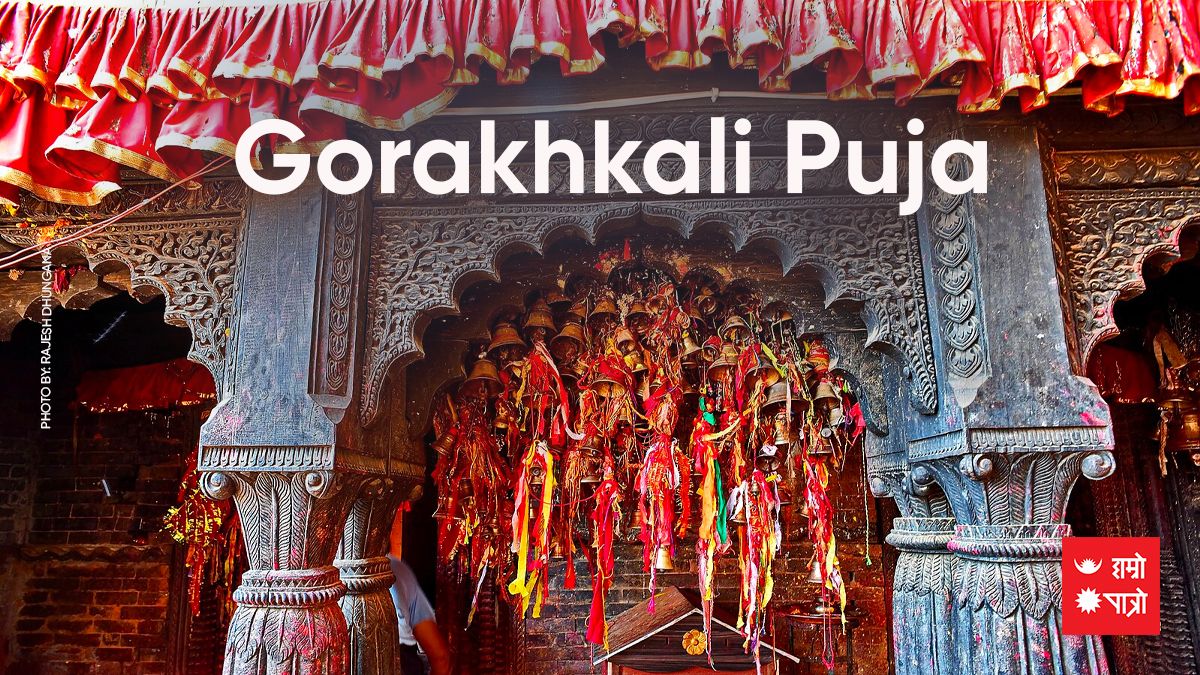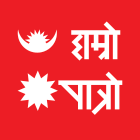Upcomming Events
-
6JesthaMohini Ekadashi Vrata today
-
7JesthaSom Pradosh Vrata tomorrow
-
8JesthaNrisingha Jayanti 2 days remaning
-
9Jestha
-
10Jestha
-
15JesthaNational Republic Day 9 days remaning
-
17JesthaGorakhkali Puja 11 days remaning
-
18JesthaWorld No Tobacco Day 12 days remaning
-
19JesthaGlobal Day Of Parents 13 days remaning
-
20JesthaApara Ekadashi Vrata (Smarta)/Chittadhar Hridaya Janma Jayanti 14 days remaning
-
21Jestha
-
22Jestha
-
23JesthaSithi Cha: Hre/World Environment Day 17 days remaning
-
24JesthaBata sabitri Vrata/Shani Jayanti Vrata 18 days remaning
-
25JesthaGosaikunda Snan Aarambha/Dasahara Snan Arambha 19 days remaning
-
27JesthaRashtriya Krishak Diwas 21 days remaning
-
30JesthaSithi Nakha/World Day Against Child Labour 24 days remaning
-
32JesthaGorakhkali Puja/World Blood Donor Day 26 days remaning
-
1AashadhaMithun Sankranti/World Elder Abuse Awareness Day 27 days remaning
-
2Aashadha
-
3Aashadha
-
4AashadhaNirjala Ekadashi Vrata (Vaisnav) 30 days remaning
-
5Aashadha
-
6AashadhaWorld Refugee Day 32 days remaning
-
7AashadhaPoornima Vrata/World Yoga Day/ Music Day 33 days remaning
-
8AashadhaJya: Punhi/Kabir Jayanti 34 days remaning
-
9AashadhaInternational Widows Day 35 days remaning
-
11AashadhaMangal Chauthi Vrata/Bhumi Pooja 37 days remaning
-
12AashadhaInternational Day against Drug Abuse and Illicit Trafficking 38 days remaning
-
15AashadhaDahi chiura Khane Din/ Rashtriya Dhan Diwas/Gorakhkali Puja 41 days remaning
-
17AashadhaInternational Cooperative Day 43 days remaning
-
18AashadhaYogini Ekadashi Vrata/World Sports Journalist Day 44 days remaning
-
19AashadhaPradosh Vrata 45 days remaning
-
22AashadhaWorld Population Day 48 days remaning
-
29AashadhaBhanu Jayanti/Surya Pooja 55 days remaning
-
30AashadhaGorakhkali Puja 56 days remaning
-
31AashadhaWorld Youth Skill Day 57 days remaning
-
1Shrawan
-
2ShrawanHarishayani Ekadashi Vrata/Chaturmaas Wrata Aarambha 59 days remaning
-
3ShrawanPradosh Vrata 60 days remaning
Jyotish
-
Jyotish Dipendra Khatiwadaसम्पुर्णानन्द संस्कृत बिश्वब...
-
Jyotish Khageshwor Subediगुरुकुल पद्दति बाट ज्योतिषीय �...
-
Jyotish Damodar Poudelनेपाल संस्कृत विश्व बिद्यालय�...
-
Jyotish Damodar Kaushikज्योतिष र व्याकरण विषयमा आचार�...
-
Jyotish Khagendra Subediसम्पूर्णानंद संस्कृत विश्ववि...
-
Jyotish hamropatrojyotish of nepal
-
Acharya Choodamani Pathakसम्पूर्णानन्दसंस्कृत विश्वव�...
-
Jyotish Smarika Acharyaबाल्मीकि बिद्यापिठ बाट ज्योत�...
-
Jyotish Deepak Prasad Kafleसम्पूर्णानन्द संस्कृत विश्वव...
-
Hamro Patro JyotishI am test jyotish please donot call.
-
Jyotish Mohan Ghimireसम्पुर्णानन्द संस्कृत विश्वव...
-
Jyotish Narayan Prasad Gautamगुरुकुल शिक्षा प्रणालीबाट ज्�...
-
Jyotish Dr. Janak Bhattaविगत ३५ वर्षदेखि कुण्डली निर्�...
-
Jyotish Mukunda Sharmaस्वाध्याय, सत्सङ्ग र सदाचारजस�...
-
Jyotish Narayan Prasad Dulalसम्पूर्णानन्द संस्कृत विश्वव...
-
Jyotish Purushottam Ghimireनेपाल संस्कृत विश्वविद्यालय, �...
-
Jyotish Vaman Sapkotaशिक्षा - व्याकरणाचार्य, पौरोही...
-
Jyotish Ghanashyam Pokharelनेपाल संस्कृत विश्वविद्यालयब...
वैशाख कृष्ण सप्तमी
International Labour Day । Budhaastami Vrata । Gorakhkali Puja

International day of labour
Many around the world tend to associate May Day with socialism and communism, as well as confine this day to Cuba and the former Soviet Union, However, it is important to see this day of labor as a more democratic and more important day in today's context. Let me take you back to the 19th century, the 19th century is known as the century of workers and their labor. The beginning of this century has embarked on the beginning of a new dimension of various factories, industries, production and development, the industrial revolution, and economic growth.
Hey Market Scandal
In commemoration of the "Hey Market Scandal" in Chicago, the USA, on May 4, 1886, before the turn of the 19th century, May 1 is celebrated as a special International Day for Labor and Labor Issues.On this day, May 1 commemorates the workers' agitation for an eight-hour day, in which an unidentified person threw a bomb at the police, and in retaliation, many innocent people were killed in a retaliatory attack by the police.Remember that before that movement, workers from all over the world used to work up to 16
hours a day. May Day has brought a momentous change in the field of labor and the credit and vision of today's growing labor-friendly society have been started from this day.

Historic phrase of the first Labor Day in 1886
It is also important to remember unknown and known labor martyrs across the globe. The English and Nepali adaptations of the historical phrase used on the first day of May 1886, are to be found here only in the courtyard of Hamro Patro.THE DAY WILL COME WHEN OUR SILENCE WILL BE MORE POWERFUL THAN THE VOICES YOU ARE THROTTLING TODAY.
अर्थात एकदिन त्यस्तो हुनेछ जब अहिलेको हाम्रो मौनतानै तिमीहरुको गर्जनभन्दा वलियो हुनेछ ।
The above phrase has addressed the industrialists of that time, in this sense, more than 130 years ago, to some extent, the gap between industrialists and workers still exists.
Nepali context of Labor day
May this May Day speak to the world about this. Institutionalize the changes that have taken place and give a working environment and the right value for labor.Without the support and involvement of Nepali laborers, no revolution, people's movement, or socio-political transformation would have been possible.Now that the definition of labor has become wider, we all Nepali are included in this wide range. The remittances coming from labor abroad have supported Nepal's economy, in that sense, most of the taxes we pay, eat, walk, and run the country are the product of the sweat of those working brothers and sisters. But the extent to which the country itself seeks to respect labor and workers is evident from the looting that begins at the airport and the brokerage system and the government's institutional silence in the vulnerable process and issues of foreign workers.
Despite the government's innumerable efforts, foreign employment has not been easy, and even within the country, the plight of the working people narrates everything.
The fear of being discriminated against as a laborer commences right from a mother showing her children to a worker from infancy, if you don't read it, is that you have to work and eat.Studying and sweating is completely different, being educated doesn't mean you should be a laborer, to create a conducive environment in Nepal, we all have to pay attention to this. Let's not educate our kids with the false hope that being educated skips them from being labor, labor is a privilege. The price of sweat is enough to make you laugh, let's restore the value of labor and reinstall smiles.
Budhaastami wrata

If an Asthami falls on Wednesday (Budhabar)- it’s a specific tithi called Budhhaasthami.
Skipping the Narka- a holy observance of Budhhasthami
Budhaastami brings several dimensions and devotion, Lord Shiva and Parwati are especially worshiped and prayed in this day, and people observe fasting and visit temples. According to the Sanatan legend, it is believed that one who observes this day of Budhaastami, never goes to hell, after death. Observers also seek divine blessings with prosperity for wellbeing in their lives.
What is done today?
Devotees also worship Budha Graha (Planet Mercury) and ask for his blessings. People with Budha doshas in their planetary locations are strongly prescribed to fast and worship this day. On this day, a special Naivedya is prepared and offered to Lord Buddha on this day, devotees worship Lord Budhha's idol inscribed in silver or on the gold coin, water-filled Kalash and green unpeeled coconut are placed atop, and several rituals are performed to appease Lord Buddha. The observer of this Vrata is believed to gain freedom from his/her sins and also escape from going to hell.
Happy Budhhaastami.
Gorakhkali Puja

Baba Gorakh and Gorakhkali Vagwati are very important in Nepali history. The meeting between Prithvi Narayan Shah and Baba Gorakh, the vomit that fell on the feet of Prithvi Narayan Shah, and the auspiciousness given by Baba Gorakh to Prithvi Narayan Shah that there will be victory wherever he bows are the reasons for the energy and strength of Nepal's unification.The glory of Gorakhnath Baba, a unique devotee of Baba Machindranath, is special in the Sanatan community of Nepal, India, and all over the world.
Gorkha, the district of origin of Shah dynasty kings adjacent to the name of Baba Gorakh, and Gorakhkali temple have special importance in the former royal family of Nepal. It should be remembered that in the history of Baba Gorakh, the Gorakh palace and dynasty, as well as the Gorakh temple in Pashupati's mrigasthali forest and Baba's 15-year meditation are also connected.
The Gorkha temple of Mrigasthali is in a state of neglect due to a lack of protection and management.
In the Gorkha Darbar area is the shrine of Gorakhkali Devi. This peetha is considered the Kool Devi of the Shah Dynasty. It is customary to worship Gorkhali on Paush Krishna Ashtami. Today, a special puja is performed at the Gorakhkali temple in Gorkha.
It has been a tradition for hundreds of years to bring Jamara to Kathmandu on Phulpati day in this Gorakhkali temple. In the post-republic years, such customs have not been given much attention, although the importance of Baba Gorakh and Gorakhkali Devi in the protection of Nepalese land has been incomparable.
Nepali people need more blessings of Baba Gorakh and Gorakhkali Devi to protect cows.
Gorakh Sandesh (Message)
Guru Gorakhnath says - "The journey of the temples and shrines is Suno Yatra" meaning the pilgrimages of the temples etc. is spiritually meaningless, equal to zero, soulless, unless we can spread love to every being in this cosmos.
देवल जात्रा सुंनि जात्रा, तीरथ जात्रा पाणीं ।
अतीत जात्रा सुफल जात्रा, बोलै अमृत वाणी ।।
Yes, the role of temples is very important in terms of religion and culture, but if there is a pilgrimage but there is no faith, there is no emotion and there is no devotion, then what is the use of just doing a "deval pilgrimage"? Do not worship people who worship idols! Run to the temple, but can't make the house a temple! Worshiping the deity of the temple but unable to awaken the divinity in himself! Offering fruit, offerings, etc. to the deity made of stone in a small area and complex, but not accepting that the divinity resides in every human, animal, and bird! And unable to serve! Seeing such religious pretentiousness, Guru Gorakhnath made a sharp satire in the Khadi language (Prakrit language, folk language, rural language). Glory be to Baba Gorakhnath and Gorakhkali Bhagwati forever.
Infinite love for Gorakhkali Puja.
-Suyog Dhakal
Upcomming Events
-
6JesthaMohini Ekadashi Vrata today
-
7JesthaSom Pradosh Vrata tomorrow
-
8JesthaNrisingha Jayanti 2 days remaning
-
9Jestha
-
10Jestha
-
15JesthaNational Republic Day 9 days remaning
-
17JesthaGorakhkali Puja 11 days remaning
-
18JesthaWorld No Tobacco Day 12 days remaning
-
19JesthaGlobal Day Of Parents 13 days remaning
-
20JesthaApara Ekadashi Vrata (Smarta)/Chittadhar Hridaya Janma Jayanti 14 days remaning
-
21Jestha
-
22Jestha
-
23JesthaSithi Cha: Hre/World Environment Day 17 days remaning
-
24JesthaBata sabitri Vrata/Shani Jayanti Vrata 18 days remaning
-
25JesthaGosaikunda Snan Aarambha/Dasahara Snan Arambha 19 days remaning
-
27JesthaRashtriya Krishak Diwas 21 days remaning
-
30JesthaSithi Nakha/World Day Against Child Labour 24 days remaning
-
32JesthaGorakhkali Puja/World Blood Donor Day 26 days remaning
-
1AashadhaMithun Sankranti/World Elder Abuse Awareness Day 27 days remaning
-
2Aashadha
-
3Aashadha
-
4AashadhaNirjala Ekadashi Vrata (Vaisnav) 30 days remaning
-
5Aashadha
-
6AashadhaWorld Refugee Day 32 days remaning
-
7AashadhaPoornima Vrata/World Yoga Day/ Music Day 33 days remaning
-
8AashadhaJya: Punhi/Kabir Jayanti 34 days remaning
-
9AashadhaInternational Widows Day 35 days remaning
-
11AashadhaMangal Chauthi Vrata/Bhumi Pooja 37 days remaning
-
12AashadhaInternational Day against Drug Abuse and Illicit Trafficking 38 days remaning
-
15AashadhaDahi chiura Khane Din/ Rashtriya Dhan Diwas/Gorakhkali Puja 41 days remaning
-
17AashadhaInternational Cooperative Day 43 days remaning
-
18AashadhaYogini Ekadashi Vrata/World Sports Journalist Day 44 days remaning
-
19AashadhaPradosh Vrata 45 days remaning
-
22AashadhaWorld Population Day 48 days remaning
-
29AashadhaBhanu Jayanti/Surya Pooja 55 days remaning
-
30AashadhaGorakhkali Puja 56 days remaning
-
31AashadhaWorld Youth Skill Day 57 days remaning
-
1Shrawan
-
2ShrawanHarishayani Ekadashi Vrata/Chaturmaas Wrata Aarambha 59 days remaning
-
3ShrawanPradosh Vrata 60 days remaning
Jyotish
-
Jyotish Dipendra Khatiwadaसम्पुर्णानन्द संस्कृत बिश्वब...
-
Jyotish Khageshwor Subediगुरुकुल पद्दति बाट ज्योतिषीय �...
-
Jyotish Damodar Poudelनेपाल संस्कृत विश्व बिद्यालय�...
-
Jyotish Damodar Kaushikज्योतिष र व्याकरण विषयमा आचार�...
-
Jyotish Khagendra Subediसम्पूर्णानंद संस्कृत विश्ववि...
-
Jyotish hamropatrojyotish of nepal
-
Acharya Choodamani Pathakसम्पूर्णानन्दसंस्कृत विश्वव�...
-
Jyotish Smarika Acharyaबाल्मीकि बिद्यापिठ बाट ज्योत�...
-
Jyotish Deepak Prasad Kafleसम्पूर्णानन्द संस्कृत विश्वव...
-
Hamro Patro JyotishI am test jyotish please donot call.
-
Jyotish Mohan Ghimireसम्पुर्णानन्द संस्कृत विश्वव...
-
Jyotish Narayan Prasad Gautamगुरुकुल शिक्षा प्रणालीबाट ज्�...
-
Jyotish Dr. Janak Bhattaविगत ३५ वर्षदेखि कुण्डली निर्�...
-
Jyotish Mukunda Sharmaस्वाध्याय, सत्सङ्ग र सदाचारजस�...
-
Jyotish Narayan Prasad Dulalसम्पूर्णानन्द संस्कृत विश्वव...
-
Jyotish Purushottam Ghimireनेपाल संस्कृत विश्वविद्यालय, �...
-
Jyotish Vaman Sapkotaशिक्षा - व्याकरणाचार्य, पौरोही...
-
Jyotish Ghanashyam Pokharelनेपाल संस्कृत विश्वविद्यालयब...
Liked by:




















 Mesh
Mesh Brish
Brish Mithun
Mithun Karkat
Karkat  Singha
Singha  Kanya
Kanya Tula
Tula Brischik
Brischik Dhanu
Dhanu  Makar
Makar  Kumbha
Kumbha Meen
Meen